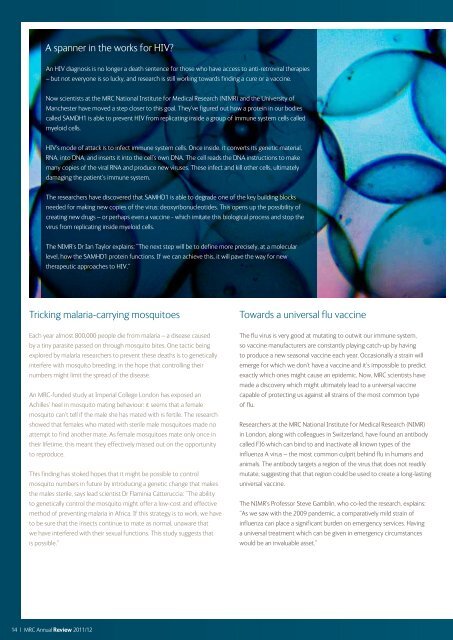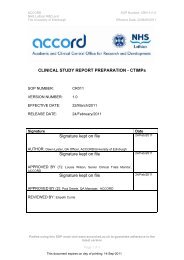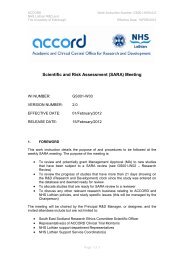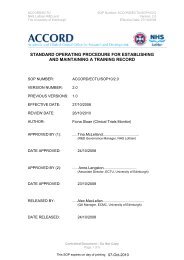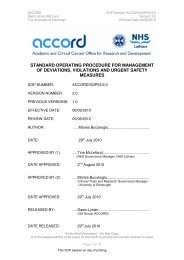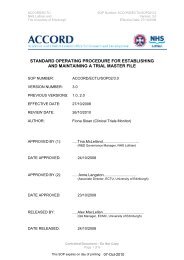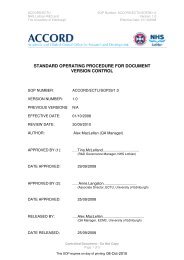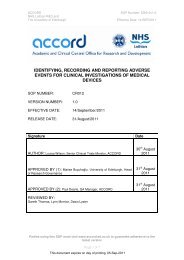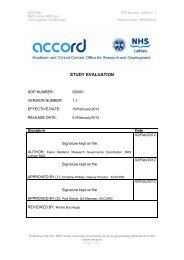Advancing medicine, changing lives - Medical Research Council
Advancing medicine, changing lives - Medical Research Council
Advancing medicine, changing lives - Medical Research Council
Create successful ePaper yourself
Turn your PDF publications into a flip-book with our unique Google optimized e-Paper software.
A spanner in the works for HIV?<br />
An HIV diagnosis is no longer a death sentence for those who have access to anti-retroviral therapies<br />
– but not everyone is so lucky, and research is still working towards finding a cure or a vaccine.<br />
Now scientists at the MRC National Institute for <strong>Medical</strong> <strong>Research</strong> (NIMR) and the University of<br />
Manchester have moved a step closer to this goal. They’ve figured out how a protein in our bodies<br />
called SAMDH1 is able to prevent HIV from replicating inside a group of immune system cells called<br />
myeloid cells.<br />
HIV’s mode of attack is to infect immune system cells. Once inside, it converts its genetic material,<br />
RNA, into DNA, and inserts it into the cell’s own DNA. The cell reads the DNA instructions to make<br />
many copies of the viral RNA and produce new viruses. These infect and kill other cells, ultimately<br />
damaging the patient’s immune system.<br />
The researchers have discovered that SAMHD1 is able to degrade one of the key building blocks<br />
needed for making new copies of the virus: deoxyribonucleotides. This opens up the possibility of<br />
creating new drugs – or perhaps even a vaccine - which imitate this biological process and stop the<br />
virus from replicating inside myeloid cells.<br />
The NIMR’s Dr Ian Taylor explains: “The next step will be to define more precisely, at a molecular<br />
level, how the SAMHD1 protein functions. If we can achieve this, it will pave the way for new<br />
therapeutic approaches to HIV.”<br />
Tricking malaria-carrying mosquitoes Towards a universal flu vaccine Discovery boosts fight against superbug Promising hepatitis C drugs in the pipeline<br />
Each year almost 800,000 people die from malaria – a disease caused<br />
by a tiny parasite passed on through mosquito bites. One tactic being<br />
explored by malaria researchers to prevent these deaths is to genetically<br />
interfere with mosquito breeding, in the hope that controlling their<br />
numbers might limit the spread of the disease.<br />
An MRC-funded study at Imperial College London has exposed an<br />
Achilles’ heel in mosquito mating behaviour: it seems that a female<br />
mosquito can’t tell if the male she has mated with is fertile. The research<br />
showed that females who mated with sterile male mosquitoes made no<br />
attempt to find another mate. As female mosquitoes mate only once in<br />
their lifetime, this meant they effectively missed out on the opportunity<br />
to reproduce.<br />
This finding has stoked hopes that it might be possible to control<br />
mosquito numbers in future by introducing a genetic change that makes<br />
the males sterile, says lead scientist Dr Flaminia Catteruccia: “The ability<br />
to genetically control the mosquito might offer a low-cost and effective<br />
method of preventing malaria in Africa. If this strategy is to work, we have<br />
to be sure that the insects continue to mate as normal, unaware that<br />
we have interfered with their sexual functions. This study suggests that<br />
is possible.”<br />
The flu virus is very good at mutating to outwit our immune system,<br />
so vaccine manufacturers are constantly playing catch-up by having<br />
to produce a new seasonal vaccine each year. Occasionally a strain will<br />
emerge for which we don’t have a vaccine and it’s impossible to predict<br />
exactly which ones might cause an epidemic. Now, MRC scientists have<br />
made a discovery which might ultimately lead to a universal vaccine<br />
capable of protecting us against all strains of the most common type<br />
of flu.<br />
<strong>Research</strong>ers at the MRC National Institute for <strong>Medical</strong> <strong>Research</strong> (NIMR)<br />
in London, along with colleagues in Switzerland, have found an antibody<br />
called FI6 which can bind to and inactivate all known types of the<br />
influenza A virus – the most common culprit behind flu in humans and<br />
animals. The antibody targets a region of the virus that does not readily<br />
mutate, suggesting that that region could be used to create a long-lasting<br />
universal vaccine.<br />
The NIMR’s Professor Steve Gamblin, who co-led the research, explains:<br />
“As we saw with the 2009 pandemic, a comparatively mild strain of<br />
influenza can place a significant burden on emergency services. Having<br />
a universal treatment which can be given in emergency circumstances<br />
would be an invaluable asset.”<br />
A breakthrough in the fight against drug-resistant infections is one<br />
step closer following the discovery of the structure of a key enzyme,<br />
NDM-1, which vicious forms of bacteria use to resist the most<br />
powerful antibiotics available.<br />
MRC scientists at the <strong>Research</strong> Complex at Harwell, Oxfordshire, led by<br />
director Professor Simon Phillips, have produced a model of NDM-1,<br />
the genes for which can be passed from one strain of bacteria to<br />
another, allowing them to destroy antibiotics. The model will enable<br />
researchers and pharmaceutical companies to progress towards<br />
potential new treatments.<br />
In recent years there has been growing concern that the usefulness of<br />
antibiotics could be coming to an end as the bacteria that cause disease<br />
become increasingly resistant to these drugs. Annually, more than<br />
25,000 people in the EU die of bacterial infections that have been able<br />
to outsmart even the newest antibiotics.<br />
But, says Professor Phillips, scientists are on the case: “While there have<br />
only been around 70 cases of infection by NDM-1 bacteria recorded in<br />
the UK so far, there is no doubt of the importance of this new discovery<br />
for saving <strong>lives</strong> in the future. Knowledge of the enzyme structure is our<br />
first step in understanding how superbugs work and leads the way to<br />
the design of drugs that might prevent their action.”<br />
More than 170 million people – 3 per cent of the world’s population -<br />
are infected with the hepatitis C virus (HCV), which is a leading cause<br />
of liver-related deaths, organ transplants and liver cancer. The infection<br />
is difficult to treat effectively because the virus evolves quickly and<br />
develops resistance to drugs.<br />
Scientists at Leeds University think they have found a way to keep<br />
the virus in check for longer. They’ve discovered details of how two<br />
prototype drugs – called p7-inhibitors – attack different parts of HCV,<br />
by targeting a protein that allows the virus to continue spreading. The<br />
study suggests these drugs could help to suppress hepatitis C when<br />
used together with other new direct acting drugs.<br />
Dr Stephen Griffin, an MRC New Investigator <strong>Research</strong> Grant holder at<br />
the University of Leeds, who led the research, explains: “This new class<br />
of small molecule drugs, the p7 inhibitors, attack the virus directly.<br />
By learning how the hepatitis C virus reacts to these molecules, we can<br />
design drugs that are likely to be more effective for longer. We can also<br />
see how such drugs could be used together with other direct-acting<br />
drugs aimed at alternative viral targets, rather than individually or with<br />
drugs that work by boosting the immune system.”<br />
14 | MRC Annual Review 2011/12 MRC Annual Review 2011/12 | 15


